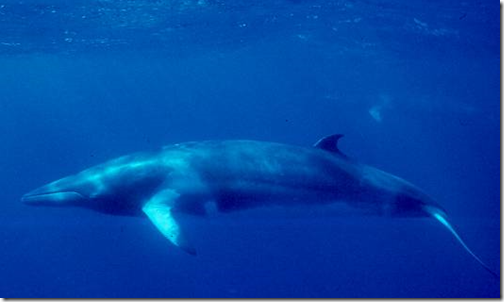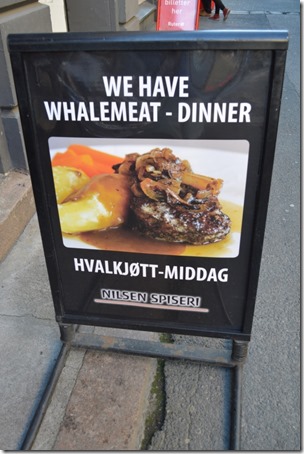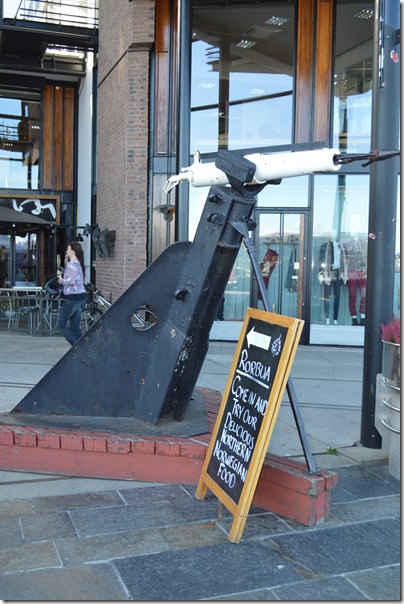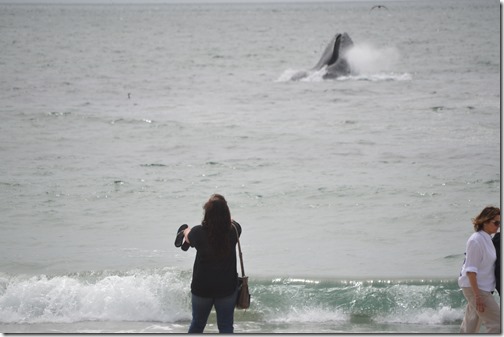Norway, Iceland and Japan still hunt whales each year, despite a worldwide moratorium on commercial whaling instituted in 1986. I have seen several restaurants in Oslo advertising whale meat on the menu.
The good summer weather is attributed for a record whaling season in Norway with 729 minke whales killed in 2014. This is the highest number of minke whales caught since Norway resumed commercial whaling in 1993. The 2014 whaling season saw a nearly 25% larger catch than 2013.

The good news? Norway’s quota was 1,286 whales for this 2014 commercial whaling season that just ended. The actual annual catches are generally far below the quota established for the annual Norwegian whaling season. The basic economics for whaling don’t add up. Norway’s whaling industry is heavily subsidized by the government while demand for whale meat across the domestic population is decreasing.
Much of the demand for whale meat in Norway’s restaurants is tourist driven.

The International Whaling Commission (IWC) instituted a ‘Zero-Catch Limits’ on commercial whaling in 1986, although participation is voluntary. Norway used to kill around 2,000 minke whales each year in the 1970s. Norway resumed commercial whaling in 1993 after concluding the common minke whale population was large enough in the North Atlantic to allow sustainable hunting. Iceland resumed commercial whaling in 2006 with the hunting of minke and fin whales. The IWC keeps a record of annual whale kills by whale species and number killed by each country.
The IWC population estimate for common minke whales in the North Atlantic is about 180,000 whales. Minke whales are not listed as an endangered species on the IUCN Red List.
What is a minke whale?
Minke whales are the second to smallest of the baleen whales, in the same rorqual family as humpback whales and blue whales. Small is relative since these marine mammals are typically 25 to 35 feet in length and weigh 4 to 6 tons. Minke whales typically live from 30 to 50 years. They are distinguished from other whale species by a white band on their flippers. Common minke whales are also known as northern minke whales.
The more numerous Antarctic minke whales, also known as southern minke whales, are a different species. Japan is the primary predator of Antarctic minke whales under an IWC loophole permitting scientific research hunting. The meat still ends up in Japanese markets.

Rorbua is one of the top rated restaurants in Oslo. The sign on the street says, “Come in and try our delicious Northern Norwegian food”. The harpoon gun was a clue to me that whale meat is on the menu.
This OnEarth.org article by Brian Palmer about this year’s Norwegian whaling season includes a video showing how a minke whale was killed by a Japanese whaling vessel. Whale: It’s What’s Not for Dinner. Anywhere.
Meet Us Don’t Eat Us – Iceland
Iceland conservationists launched a “Meet Us Don’t Eat Us” campaign in 2010 to encourage tourists not to buy whale meat at restaurants.
Think before you eat whale meat
I have been thinking about whales quite a bit this summer. I have talked with dozens of tourists in 2014 who came to Monterey Bay, California in the hope of seeing a live whale in the sea. I have been around hundreds of tourists as we watched humpback and gray whales surface along the California coast this year. It seemed like every week there were more people flocking to Monterey Bay as news spread around the world about the numerous sightings of humpback whales close to shore.
For the past three days I have been on the coast of southeastern Norway and spent many hours watching the sea. The sea has been calm. I have seen dozens of ducks and two beautiful white swans. Even saw some jellies in the water. But there has been no sign of marine mammals in this part of Norway on the southeast coast. Perhaps I’ll see more sea life in Bergen this week.
If you want to eat whale meat, come to Norway and plunk down your credit card for an authentic and expensive restaurant meal.
But, if you want to meet whales, then I suggest you come to Monterey Bay, California where whales feed the appetite of tens of thousands of tourists each month over and over again.
That is truly sustainable whaling culture.

*****
Norway whale catch reaches highest number since 1993 – The Guardian UK (August 25, 2014)
Norwegian whaling – based on a balanced ecosystem – Fisheries.no – the Official Norwegian site (March 19, 2013)
Norwegian Whaling (pdf) – Whale and Dolphin Conservation Society StopWhaling.org (June 2011)
Minke Whales Feast Under Antarctic Ice, Study Finds – Their frequent gulps for krill is fastest “lunge” rate ever observed. – National Geographic (August 2014)
Loyalty Traveler – Humpback whales in our faces at Moss Landing beach (July 29, 2014)
Loyalty Traveler – Shore Whalers History at Point Lobos State Park, California (June 30, 2013) is a piece I wrote about 19th century whaling culture near Monterey. About 250 whales were killed and processed in a 22 year period, primarily for lamp oil.
*****
Ric Garrido of Monterey, California is writer and owner of Loyalty Traveler.
Loyalty Traveler shares news and views on hotels, hotel loyalty programs and vacation destinations for frequent guests. Check out current hotel loyalty program offers across all the major chains in Loyalty Traveler’s monthly hotel promotions guide.
Follow Loyalty Traveler on Twitter and Facebook and RSS feed.



11 Comments
Comments are closed.